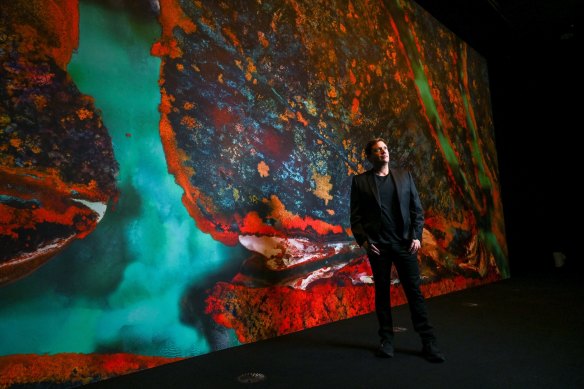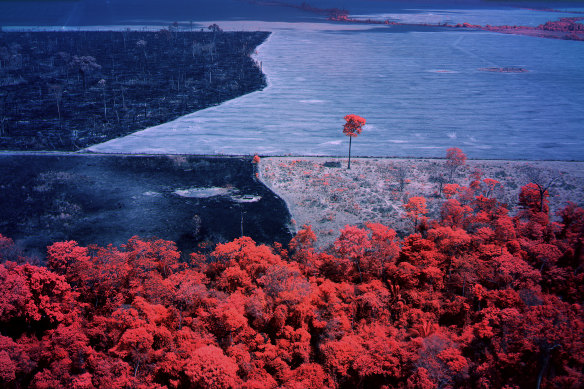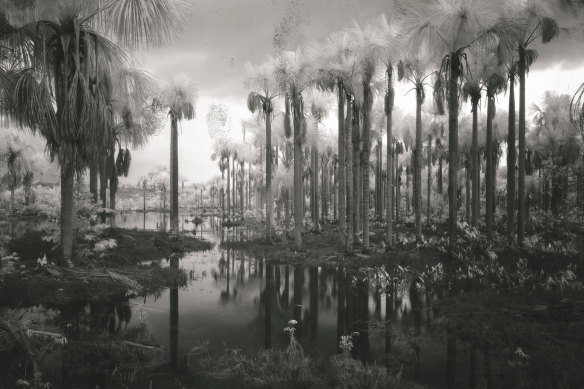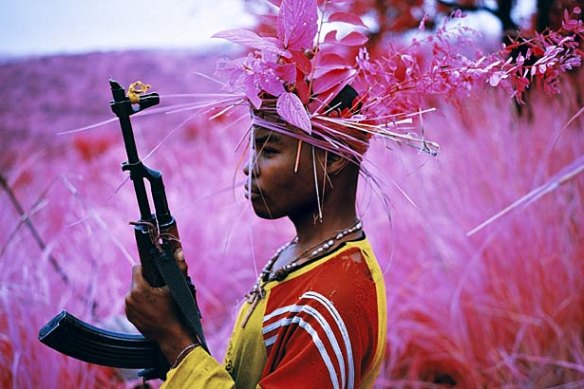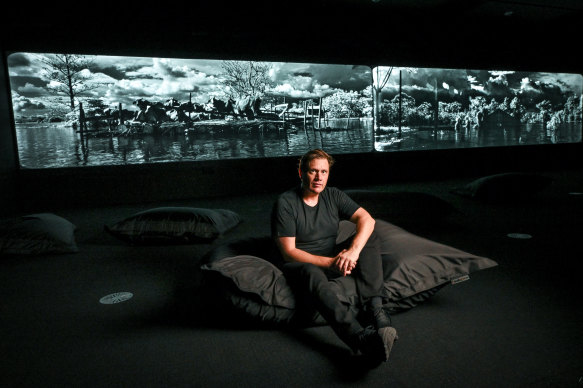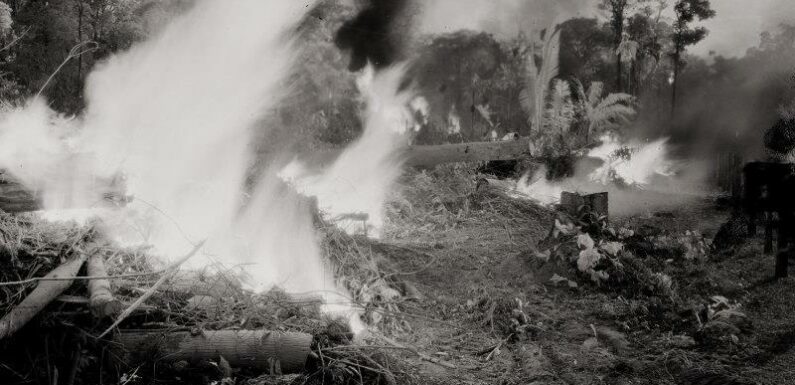
It may seem remarkable that anyone would view their short-term profits as more important than the survival of humankind, but this is the simple reason we’re losing the battle against global warming. The complex reason is slightly trickier. In the words of British philosopher Timothy Morton the warming of the planet is a “hyperobject” – so massive and diffuse that it defeats our understanding of space and time. We find it conceptually difficult to connect so many diverse events in different corners of the world – wildfires in Europe, floods in Pakistan – and see them as one thing.
Morton may be stating the obvious in an elaborate manner, but it’s useful to have a term that helps define our complacency in the face of apocalypse.
The Irish photographer Richard Mosse has talked about “hyperobjects” in relation to a body of work so politically and aesthetically ambitious it defies comparisons. It’s commonplace for artists to claim a cheap profundity for a piece that signals their concern with issues of politics or identity, but Mosse spends much of his time in the field, usually in the most inhospitable locations. His new film, Broken Spectre, which debuted at the National Gallery of Victoria last week, is the result of three years’ toil in the Amazon basin, tracking the destruction of the rainforest.
Artist Richard Mosse at the NGV.Credit:Eddie Jim
The statistics are well-known but bear repeating: the Amazon produces more than six per cent of the world’s oxygen, it contains 40 per cent of the world’s remaining rainforest and 25 per cent of its biodiversity. At present, an area of forest larger than a football field is being cleared every minute. By 2030, more than a quarter of the jungle will be gone, and by 2050, with the escalating effects of global warming, it could be entirely lost. Under the administration of Jair Bolsonaro, elected in 2018, and currently angling for a second term, exploitation of the Amazon has increased by more than 90 per cent.
Along with his chief collaborators, US cinematographer Trevor Tweeten and Australian sound artist Ben Frost, Mosse made repeated visits to areas where the worst environmental crimes were being carried out. In these places ancient forests were being obliterated, Indigenous people terrorised, and activists murdered.
The technical challenges Mosse set himself were almost as daunting as his choice of locations. The artist and his crew travelled with a special, custom-built device that he says is the world’s first and only multi-spectral motion picture camera, developed in collaboration with a tech expert. The camera, allegedly as large as a refrigerator, was strapped to the front of a helicopter to capture hours of multi-coloured, bird’s eye surveys of the forest.
Broken Spectre 2022 (still). Credit:Richard Mosse
On the ground, Mosse used infra-red film to shoot sequences in black-and-white, thereby accentuating contrasts. He is, perhaps, the first director to employ this medium since Mikhail Kalatozov in the Soviet-era classic I Am Cuba (1964). To develop the film, Mosse had to track down an antiquated piece of technology, then convince his studio manager to spend months patiently working through the footage.
Out of this set of difficult, dangerous, painstaking processes, an original and powerful work of political art has emerged. It unfolds on a 20-metre screen, often divided into three separate segments, but occasionally unified into a single panoramic shot.
We see the Amazon from the air as a mass of saturated colour, a pale blue river snaking its way through a bright red forest. Back on earth we follow the Brazilian cowboys, the vaqueiros, who are burning the forests, clearing pasture and running cattle. We see the small gold miners, eking out an illegal living, while poisoning the rivers with mercury. We see wildlife on the banks of the river, and scenes of teeming undergrowth in which plants and insects inhabit a kind of alternative cosmos. We see thousands of head of cattle penned up, awaiting slaughter, and the grisly business of the abattoirs. Towards the end, we visit a village near the Venezuelan border, where we meet native people driven to desperation. Suddenly, we are in Brasilia, with tens of thousands of Indigenous protesters rallying outside the Supreme Court to oppose the destructive – or as they say, genocidal – policies of the Bolsonaro government.
Broken Spectre 2022 (still).
The film begins with a bucolic scene of a family working at a small ranch. A little boy plays with toy animals while a calf is fed with a bottle. The background music is borrowed from Ennio Morricone, suggesting we are about to watch a spaghetti western. It was only on a second viewing that I became conscious of the landscape, which was stark and bare, filled with blackened tree trunks lying on the ground.
There are many scenes of ordinary people going about their daily work. Gradually we realise that each of these jobs is contributing to the degradation of the Amazon, the loss of habitat and biodiversity, the dispossession of tribes. For an entire generation of people, the destruction has become normalised, a part of daily life and family patrimony. Most of this is actually illegal, but authorities under Bolsonaro have learned to turn a blind eye.
From scenes in which we watch men burning the forest or chainsawing trees that took 800 years to grow, we switch to images of storks, or otters, or a jaguar prowling by the riverside. Then we’re back to the jungle, laid out in psychedelic colours, listening to a surging electronic soundscape by Ben Frost.
Mosse became known for his distinctive approach to colour when he represented Ireland at the 2013 Venice Biennale with a film called The Enclave. There wasn’t anything Irish about this multiscreen projection, which captured confronting scenes of civil war in the Congo on 16 mm colour infrared film. The film stock, which had been developed by the United States as a reconnaissance tool during the Second World War, had the bizarre effect of turning every trace of green into a lurid pink. Black soldiers traipsed through a crimson jungle, carrying AK-47s. All the death and destruction, the miseries and privations of war were on display, but in shades that turned the setting into a science fiction landscape.
Richard Mosse’s The Enclave.Credit:Richard Mosse
Mosse followed The Enclave with Incoming (2017), a devastating film about the global refugee crisis, but Broken Spectre, is his most ambitious project to date. It takes its title partly from the optical illusion called the Brocken Spectre, whereby a human shadow is cast on a giant scale across the landscape. Today, the entire planet stands in that shadow, as we become aware of the damage wrought by the so-called Anthropocene era.
The standard criticism of Mosse’s work is that he aestheticises scenes of injustice and suffering. Against this, one must put all those worthy, gritty documentaries that are universally applauded but rarely watched. Mosse’s unusual approach adds a poetic dimension to his treatment of urgent political issues. Viewers will remember this film, as they do The Enclave, long after they’ve forgotten a more conventional documentary.
Artist Richard Mosse sits in front of the 20 metre-long screen which is playing his new work, Broken Spectre.Credit:Eddie Jim
They will also remember a long address to the camera by a young native woman named Adneia, who speaks passionately about the ravages of “Bolsonaro’s children” against the environment and the local people. “You say you’re here to support us,” she says to the filmmaker and to us, “don’t say that for nothing.”
Nothing is what will be left if the “Brazilian Trump” is returned to power in the October elections, as the constant burning of jungle is rapidly transforming the world’s greatest carbon sink into a major carbon emitter. It’s been said many times that when the Amazon goes, we are all gone. This beautiful, horrifying film shows how close we’ve come to the edge.
Richard Mosse: Broken Spectre is at the National Gallery of Victoria, Melbourne, until April 23.
John McDonald was a guest of the National Gallery of Victoria
To read more from Spectrum, visit our page here.
The Booklist is a weekly newsletter for book lovers from books editor Jason Steger. Get it delivered every Friday.
Most Viewed in Culture
From our partners
Source: Read Full Article
